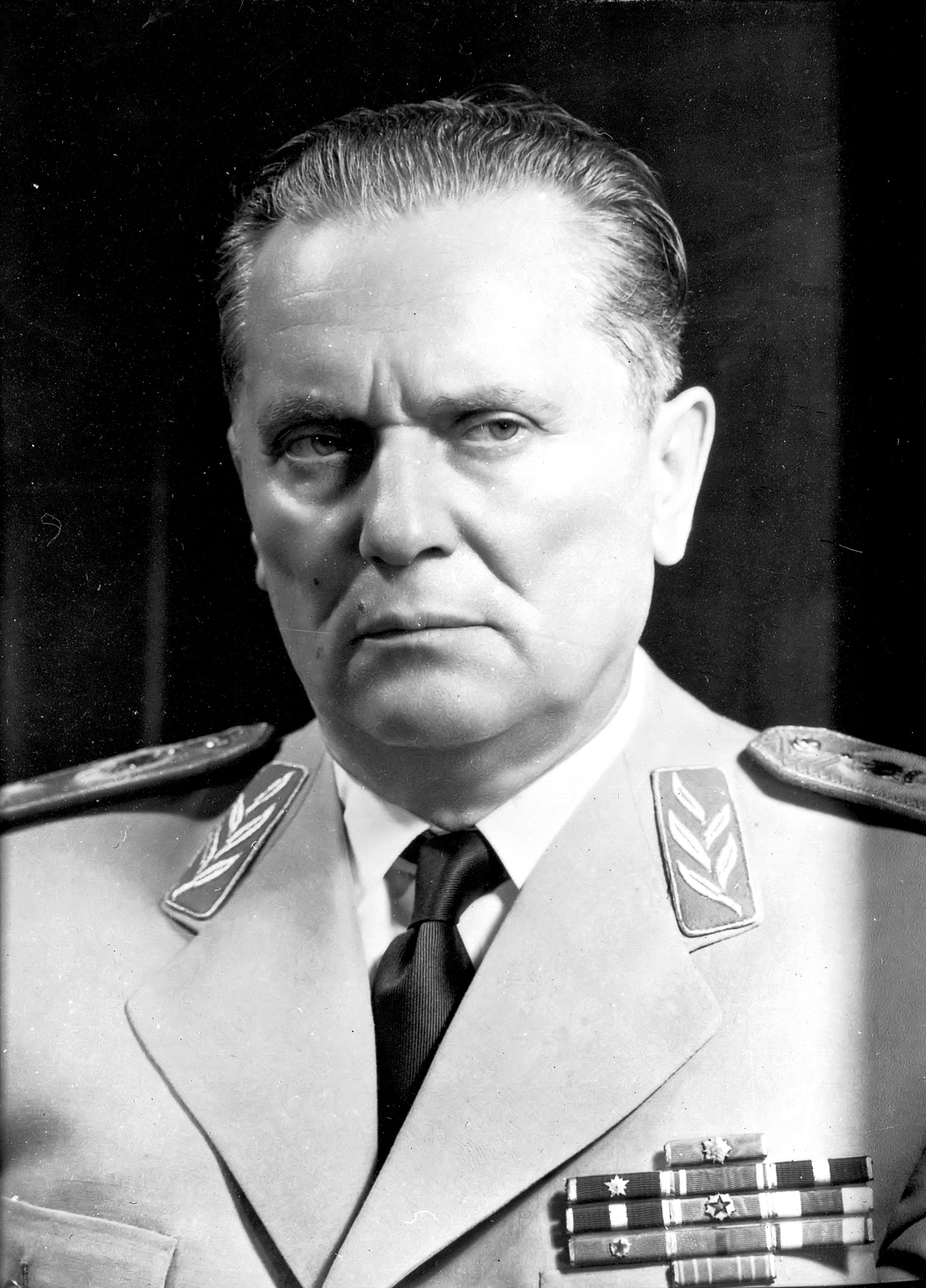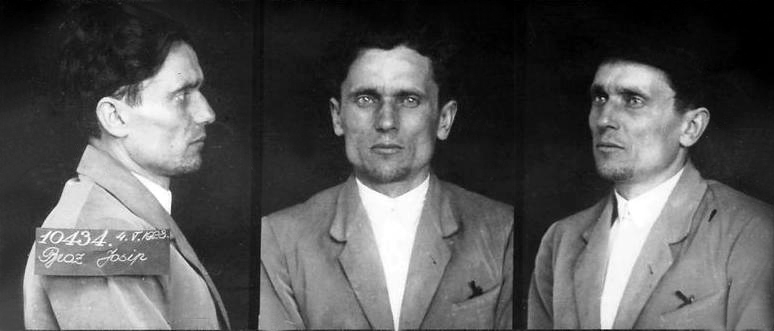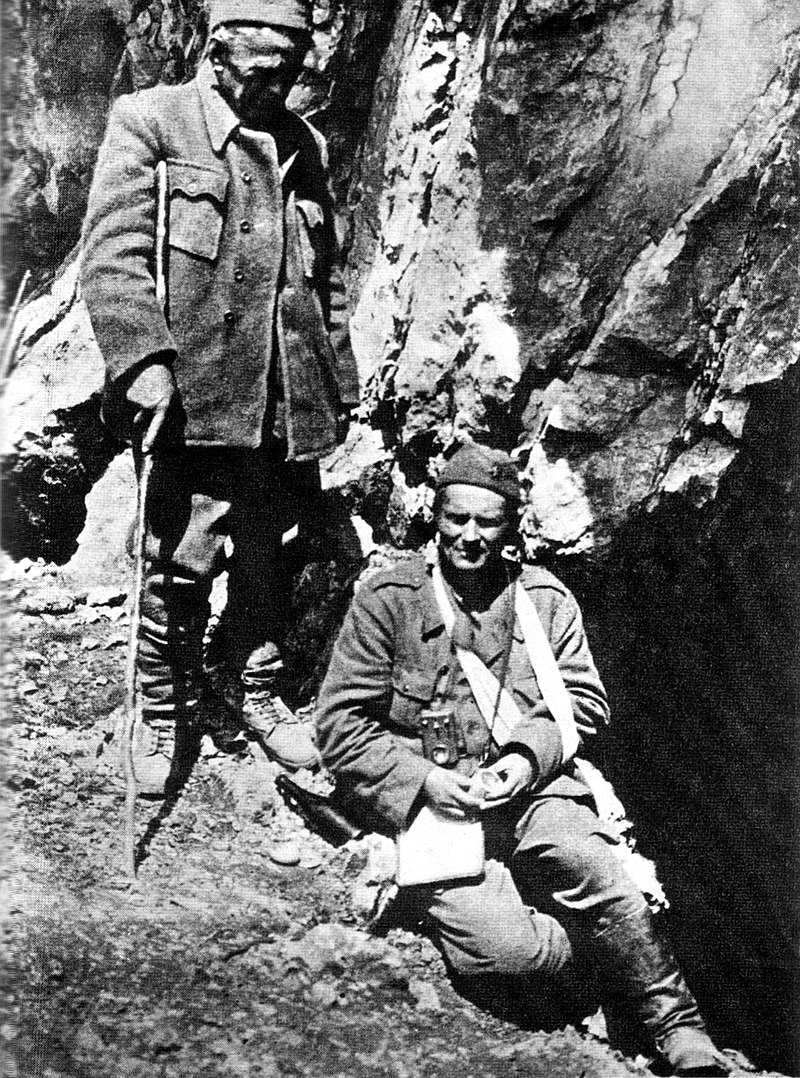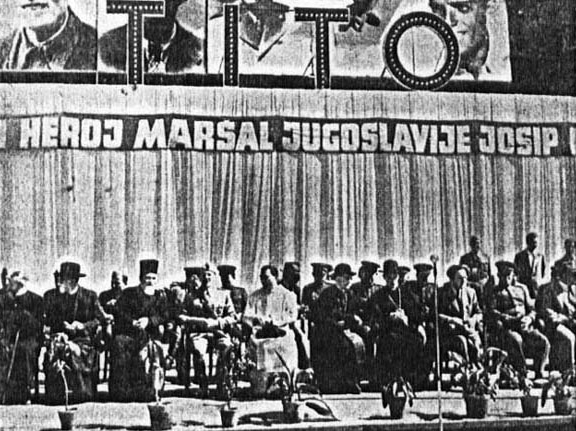It takes a tough skin to be a leader of a Country, even more so of a Country that basically did not exist until a few years before you took power, even more so if that Country is torn between two cold-warring blocks, locked in an arm-wrestling contest that will result in total destruction … and yet you manage to give the middle-finger to both factions and do your own thing.
This is the story of the leader of post-war Yugoslavia. He kept together a federation made up of six nationalities for 35 years; he led the non-aligned movement during the Cold war years; and he survived the assassination attempts of the most dangerous men on the planet, including Mr Josef Stalin. Please welcome today’s protagonist: Josip Broz, better known as “Tito”, the man who could not be killed.

The Young Sergeant
Josip Broz was born on the 7th of May 1892 in the town of Kumrovec, near Zagreb, modern day Croatia, into a large peasant family. Croatia at that time was part of the Austro-Hungarian Empire, a patchwork of nationalities in Central Europe which had recently expanded into the Balkans. Josip was a perfect example of this multi-nationalism, being born of a Croat father and a Slovene mother.
Very little is known about Josip’s parents and his early schooling. Actually, even his birth date and his real name are disputed[TA2] . This is the extent to which the man’s life was shrouded in mystery. That is why we will skip straight to his teenage years, and trying to navigate as much as possible the certain facts of his life.
Aged 15, Josip was apprenticed to a locksmith in 1907 and in 1910 he completed his training and started working as an itinerant metal worker in Austria and Germany. It was around this time that he joined the Social Democratic Party of Croatia-Slavonia in Zagreb, his first sign of political engagement.

Josip’s life changed for good in 1913, when he was drafted into the Austro-Hungarian army. He clearly had a talent for soldiering as he was singled out for non-commissioned officer training, and by summer 1914 he had become the youngest Sergeant-Major in that army. Of course, the summer of 1914 was not a good time to be a soldier – let alone an NCO – in the Austro-Hungarian army, or any other army for that matter. As the first shots of WWI rung out, Josip and his unit were sent to invade Serbia, facing an unexpectedly stiff resistance. But Josip was a good squad leader and in early 1915 he was transferred to Austria-Hungary’s most important front in the East, to face Russia.
This was an even tougher opponent and Vienna’s armies did not do well. In general, Josip’s experience with the Austro-Hungarian Army strengthened his belief that it was not much of an armed force, ineffective in a real war, but used merely as an instrument of oppression against Slavic nationalities and the lower echelons of society.
On the 4th of April 1915 Josip’s unit was overrun by a cavalry charge. This was the first documented occasion in which young Sergeant Broz proved that he was a tough cookie and would not go down easily. One of the Russian cavalry men charged straight at him, but Josip, being a good fencer, was able to deflect his two-metre lance and fight him off. Another Czarist soldier, though, attacked him from behind and pierced him close to the heart. That could have been the end of this story, but Josip survived, albeit severely wounded and was captured by the Russians. Over the following two years of hospitalisation and captivity, the once social-democrat became acquainted with a much more radical ideology: Bolshevism.[TA3]
Becoming a Communist
By 1917 he had been completely bought over by the majority Communist faction and had renounced any affiliation with Vienna’s armies. In February 1917 the Czar had been ousted by Kerenskij’s moderate government, which did not sit well with the Bolsheviks, nor with Josip, who actively participated in the July Days demonstrations in Petrograd and in the October Revolution which eventually brought Lenin to power.
When the new Soviet government signed the Brest-Litovsk agreement with the Central Powers, which left Russia out of the war, Josip could have easily returned home. But it tells something about the steely character of the young activist that he decided to join instead a Red Guard unit in Omsk, Siberia, to continue the fight in the Russian Civil War against the reactionary ‘White’ armies.
Following a White counteroffensive Josip fled to modern day Kyrgyzstan, but was able to return to Omsk and join the newly formed South Slav section of the Bolshevik party – whilst getting married along the way. Finally, in October 1920 he returned to his native Croatia. In the meanwhile, the Austro-Hungarian Empire had dissolved, giving birth to several new Countries in Central and Eastern Europe, one of these being the Kingdom of the Serbs, Croats, and Slovenes – later better known as Yugoslavia.
Upon returning, Josip had joined straight away the Communist Party of Yugoslavia (CPY). He must have jinxed it, because the Yugoslav government immediately banned all communist activities. For the next three years, the CPY went quiet, and so did Josip, resuming work at a metal mill near Zagreb.
But in 1923 Josip made contact again with the CPY, which had by now gone underground. It seems like clandestine activity suited well the young metal worker, as he thrived in the communist organisation.
He first acted as a party functionary and trade union organizer in Croatia and Serbia until 1927, when he was promoted organisational secretary for the Zagreb CPY committee. His tenure in this office attracted the attention of Moscow and of the Comintern, the Soviet-sponsored organization of international communism.
The Comintern rewarded him with an appointment as Zagreb’s political secretary in April 1928. After the assassination of a Croat member of parliament in June 1928, Josip took the occasion to take the CPY out of the shadows, by staging street demonstrations against the authorities. But they reacted swiftly: Josip’s apartment was raided by the police which found explosive material, proving his adherence to the insurrectionary hardline of the Comintern. Broz was arrested in August and sentenced to a five-year term, but the trial gave him a stage to voice his convictions and gain credit with the party authorities.

While Josip was in prison, Yugoslavia was in turmoil, forever torn by the two opposite tensions of centralization versus autonomy of its constituent nations and autonomous provinces; which by the way are Slovenia, Croatia, Bosnia-Herzegovina, Serbia, Montenegro, Macedonia, Kosovo and Vojvodina.
During this period the King Alexander I established a dictatorship to stem the nationalistic aspirations of non-Serbian populations. The regime also cracked down on the Communist party by ordering the arrest of most of its leadership.
The cadres of the party needed to be replenished. That is why, when Broz was released in March 1934, the leader in exile of the CPY, Milan Gorkić, summoned him to his Vienna headquarters to give him a position in the party’s Politburo. This was Josip Broz taking his political career to the next level, from local representative to one of the national leaders.
It was also the occasion in which he assumed his distinctive pseudonym: Tito
Tito Begins
From February 1935 to October 1936, Tito moved to the Soviet Union to work more closely with the Comintern and develop ties with Bolshevik leadership which would prove useful in his climb to power. In 1937 and 38, Joseph Stalin launched his campaign of purges against political and military leaders in the USSR, which, through the Comintern, extended to other Communist parties across Europe. The CPY was not exempt, and Gorkić, among others, was executed.
According to Serbian journalist Pero Simic, [TA4] Tito actively profited from the Stalinist repression. He took the occasion to spy or even actively betray some of his comrades and friends, thus painting himself in a good light with the Comintern. He was rewarded with a mandate to re-build the CPY’s Politburo with his hand-picked lieutenants — among them one Milovan Djilas, whom we’ll encounter again later. And of course, the natural next step was for Moscow to appoint him new secretary-general of the CPY. By 1939, Tito’s grip over Yugoslavian Communist was undisputed and he started laying plans for the future of the Country. At a clandestine conference in Zagreb in October 1940 Tito revealed his strategy: first, leverage the 24000 members of the party to launch an armed insurrection against Alexander I’s reign; second, establish a federal state, USSR-style, to address the ongoing issue of Yugoslavia’s multiple nationalities.

Dangerous Times, Dangerous Men
The big occasion for armed insurgency presented itself in Yugoslavia’s darkest hour. In April 1941, the Kingdom was occupied and partitioned by the Axis powers, mainly Germany and Italy, but also Romania and Bulgaria.
The Yugoslavian theatre during WWII was – to put it mildly – a confusing mess, which contributed to sowing the seeds of enmity amongst its building blocks. But I’ll do my best to explain it.
After the occupation, the main resistance force were the Serbian Chetniks of Dragoljub Mihailović, loyal to the government in exile and supported by the Allies. The CPY had organised its own parallel Partisan network, led by Tito, with the multiple agenda of kicking out the Axis, defeating the Chetniks and taking over Yugoslavia to install a Communist regime. Other factions, on the other hand, had started collaborating with the Axis, mainly the Croatian fascist party, or Ustasha.
In 1942, Italian General Mario Roatta, also known as “The Black Beast” was charged with quashing the Communist insurgents. To this end he sought – and obtained – an alliance with the Chetniks, ideologically opposed to Tito’s men. Roatta’s Italian 2nd Army and his Chetniks auxiliaries launched a violent repression not only against the Partisans, but also civilian populations in Slovenia and Croatia, especially in areas bordering Italy. An interesting aside: while Roatta was a total dick to Yugoslavs, he was actively helping Jews escape from the Ustasha and the Gestapo, facilitating their relocation to neutral countries.
But the result of the Chetnik’s changing sides? The Allies shifted their support from Mihailovic to Tito, who was able to increase the scale of his operations. Leading a successful guerrilla campaign, the Communist leader was able to control most of Bosnia by November 1943, even establishing an independent Government. [TA5]
Tito had by now become such a nuisance to the Axis that Hitler took direct interest. He charged his most effective henchman with the secret mission to locate and assassinate Tito and the Partisan leadership. This henchman was legendary SS Commando Otto Skorzeny, already known by then as
‘the Most Dangerous Man in Europe’.
In February 1944 Skorzeny launched a two-pronged offensive: ground forces were to surround the identified location of Tito’s headquarters, a cave on the Bosnian mountains. While the regular troops would distract the Partisan forces, Skorzeny would attack the headquarters with his signature move, a combination of gliders and paratroopers.
But the Germans had underestimated the CPY fighters: they put up a stiff and prolonged resistance, pushing back both prongs of the attack and allowing Tito to escape to safety. [TA6]
Both the Black Beast and the Most Dangerous Man in Europe had failed to catch or kill Tito.
The government in exile by now had to admit that they had to negotiate with this man. In June 1944 the royal Prime Minister in exile, Ivan Šubašić, met with Tito and agreed to coordinate their activities to complete the liberation of the Country. But any hopes of restoring the monarchy were quashed by the Soviet army: aided by Tito’s Partisans, in October 1944 they liberated Serbia, the last monarchist stronghold.

As Germany retreated and the Fascist state in Northern Italy collapsed in April 1945, Tito’s Communist forces extended their control of the whole of Yugoslavia, achieving total victory by May 1945.
But Tito’s Partisans did not stop there. Taking advantage of the Axis’ powers collapse, they extended the national frontiers by taking the Istrian peninsula and portions of the Julian Alps, territories disputed with Italy since the end of WWI. The occupation gave way to brutal reprisals which struck retreating Axis soldiers, Croat and Slovene collaborationist, as well as Italian civilians. It is estimated that up to 15,000 were killed, many thrown still alive into the natural wells typical of the region, known as ‘foibas’.[TA7]
A Tale of Two Islands
As the War ended, Yugoslavia was still a Monarchy, albeit with Tito as Prime Minister. But after a major election victory in November 1945 – 80% of the vote! – Tito took full control of the Country, exiled King Peter II and declared the Republic … although it would be fairer to describe it as a dictatorship.
His first years in power were particularly brutal. In order to consolidate his power, Tito started purging in pure Stalin-style. Mihajlovic, leader of the Chetniks, and other opposition leaders were executed. The Archbishop of Zagreb and other members of the Catholic clergy were incarcerated. Tito then moved to nationalize industry and undertake a planned economy, a plan which included forcing small farmers to give up large portions of their produce to the state.[TA8]

So far, so good, as Tito was fashioning himself as a bargain Stalin of the Balkans. But Tito and the Big Man in Moscow clashed when the Yugoslav leader intended “exporting” his brand of communism to Albania and Greece, at a time in which the official Comintern line was very cautious.
In the spring of 1948, Stalin started planning for a purge of the CPY, but Tito was able to maintain control over his party, the army, and the secret police.
Over in Moscow Stalin, who would not have a ‘niet’ for an answer, disowned his old comrade. He publicly condemned Tito, expelled the CPY from the Comintern and economically boycotted Yugoslavia.
Tito, who was above all a pragmatist, did not shed tears over the rift with his BFFs in Moscow and initiated a gradual shift towards the West, maintaining nonetheless a political doctrine equidistant from both Nato and the Warsaw Pact.
Inside his borders, Tito tightened the grip on power aided by a very effective secret police. These guys started by cracking down on filo-Stalinist and later on other dissenters, many of whom (up to 600 over the years) would be tortured to death in Tito’s high security political prison, Goli Otok, also known as “Devil’s Island”.[TA9]
As it befits such a contradictory character, Tito also enjoyed the natural beauty of a “paradise island”, the isle of Vanga in the Brijuni archipelago, northern Adriatic. This island was home to one of his many presidential residences and the one he used to entertain many political leaders, from Fidel Castro to Queen Elisabeth and Persian Shah Reza Pahlavi. But Tito had a soft spot for film stars, too – and Elizabeth Taylor and Sofia Loren, to mention just two, were among the many actresses to pay regular visits.[TA10]
A Note to Stalin[TA11]
Before we continue with the story of Tito’s rule in Yugoslavia, let me tell you about some juicy details of the rivalry between Tito and Stalin. As you may have guessed, Tito’s move for independence from Moscow had not made Stalin very happy. It was not only that. It seems like Stalin was also fearful and even jealous of the Yugoslav leader, which made him consider the serious possibility of having him killed.
Now, that’s enemy you don’t want to have. Otto Skorzeny may have been the Most Dangerous Man in Europe, but he was the Cookie Monster compared to Josef Stalin. Soon, Lavrenti Berija, head of the NKVD, was put on the case.
Stalin’s spymaster orchestrated no less than 22 assassination attempts against Tito. These included increasingly outlandish methods, ranging from your standard weapons such as a rifle, or a bomb, and then going into James Bond territory. One attempt for example involved an ornate jewellery box, which would release a cloud of toxic nerve gas when opened. But my personal best involved ‘Max’, real name Iosif Grigulevich, the Soviet agent responsible for the brutal murder of Stalin’s other big rival, Leon Trostky.
According to a secret memo, Max was instructed to infiltrate a diplomatic reception in Belgrade, posing as the Costa Rican diplomat, Teodoro Castro. Once there, Max was to release Berija’s most secret weapon: a lethal plague bacteria.
“The death of Tito and every other person in the room would be guaranteed,” the memo said. “Max himself would not know anything about the nature of the substance. To save his life, Max would be immunised against plague beforehand.”
Now, that’s what I call real, pure hatred. But luckily for Tito, and indeed for the whole population of Belgrade, Stalin’s death in March 1953 meant the hit was called off and Grigulevich was recalled to Moscow.[TA12]
Speaking of Stalin’s death … it was a stroke, right? Well, according to Slovenian historian Joze Pirjavec, there may be something else behind it – or rather someone else.
Pirjavec claims that Stalin may have been poisoned with potassium cyanide and that the poisoning had been ordered by none other than Tito, in retaliation for the attempted assassinations against him. If this is true, it would be the fulfilment of a famous note sent by Tito to Stalin, one which may well be the most bad-ass letter ever written:
“Stalin:
Stop sending people to kill me! We’ve already captured five of them, one with a bomb and another with a rifle…
If you don’t stop sending killers, I’ll send one to Moscow.
And I won’t have to send another”[TA13]
Leader of the Non-Aligned
And … let’s get back to politics! As he moved Westwards, also Tito’s internal policy started to thaw towards a more liberal stance. This was mainly thanks to his deputy and chief advisor, Milovan Djilas[TA14] , an old chum from the early days of the clandestine CPY. Together they shaped a type of socialism that allowed workers to manage industrial enterprises and even share profits, which was a pretty liberal idea by Communist standards. Tito also relaxed many of the regime’s strict controls, particularly those affecting small farmers. As a result, Yugoslavia became the most liberal Communist country of Europe.[TA15]
The West reacted positively by offering financial aid and military assistance. By 1953, Tito had even signed a mutual defence pact with Greece and Turkey, which equated to an informal association with NATO.
After Stalin’s death in 1953 – by poison or by stroke – Djilas proposed further reforms which would have accelerated the drift towards the West, most importantly to give up the one-party system. Tito, however, rejected this proposal in January 1954, which led to a rift with his trusted vice-president, and his eventual exile.
Tito preferred, instead, exploring a reconciliation with the new Soviet leadership under Nikita Khrushchev, who visited Belgrade in May 1955. The two leaders agreed on the Belgrade declaration, which committed Soviet leaders to equality in relations with the other communist countries, a big step forward in formalising at least Yugoslavia’s independence from Moscow.
But in the following years Khrushchev and his successor Brezhnev happily wiped their backsides with the Belgrade declaration, by crushing the Hungarian revolution in 1956 and the Prague Spring in 1968. In both cases, Moscow blamed Tito for inspiring these dissident movements, which led again to frosty Soviet-Yugoslav relationships.
Disillusioned with both the West and the Communist bloc, Tito eventually sought like-minded statesmen elsewhere and he found them amongst the leaders of the developing countries. Negotiations with Gamal Abdel Nasser of Egypt and Jawaharlal Nehru of India in June 1956 led to a closer cooperation among states that were “non-engaged” in the East-West confrontation.
From non-engagement Tito developed the concept of “active nonalignment”—that is, the promotion of alternatives to bloc politics, as opposed to mere neutrality. The first meeting of nonaligned states took place in Belgrade under Tito’s sponsorship and guidance in 1961.
Keeping it together
Since the days of WWII and internal divisions exploited by the Axis powers, Tito’s big preoccupation on the home front was to maintain the unity of Yugoslavia. This was the only way by which the federation could maintain its independence from Moscow and increasingly limited reliance on the West. As Tito declared:
“We have spilt an ocean of blood for the brotherhood and unity of our peoples and we shall not allow anyone to touch or destroy it from within. None of our republics would be anything if we weren’t all together; but we have to create our own history – history of United Yugoslavia, also in the future.”[TA16] [TA17]
But Tito’s concept of internal brotherhood was to be increasingly threatened by demands of de-centralisation in the 1960s and 1970s.
Ironically, it was his ‘big idea’ of workers’ self-management which gradually shifted the balance of power away from the central party authority and from federal government. The resulting tensions for autonomy, first in the factories, then in provincial centres, opened cracks within the CPY leadership between 1963 and 1972. During this period Tito launched a second wave of purges, first addressing factions who wanted to increase centralisation of power and later Croatian and Serbian liberals who were calling for more autonomy in their respective nations.

Tito’s response to the crises of the 1960s and early ’70s was to fashion a system of “symmetrical federalism,” supposed to formalize equality among the six republics and Serbia’s two autonomous provinces (Kosovo and the Vojvodina).
Unfortunately this system, while not providing enough autonomy to the smaller republics, also annoyed the two largest, Serbia and Croatia, that felt they were giving them too much autonomy! To put it simply: Tito tried to make everyone happy … and he managed to piss them all off instead. Only Tito’s prestige and personal charisma was now holding together a very fragile federation.
Death and Legacy[TA18]

Everyone in former Yugoslavia now remembers where they were on the 4th of May 1980. This was the day in which Tito died of heart failure, aged 88. During his remarkable life the leader always aimed to find a balance, a third way, oscillating between East and West, Communism and Capitalism, Peace and War, Devil’s Island and his own private paradise. His toughest balancing act, the one between centralisation and local autonomy, eventually did not survive. Eleven years after Tito’s death, the former federation disintegrated amid a series of bloody battles and ethnic hatred reminiscent of the war already fought on those lands four decades earlier. But that’s another story, which I’m sure we’ll tell one day or the other.
[TA1]The main biographical data is referenced to https://www.britannica.com/biography/Josip-Broz-Tito
… unless noted otherwise!
[TA2]https://www.eurozine.com/tito-between-legend-and-thriller/
[TA4]https://www.eurozine.com/tito-between-legend-and-thriller/
[TA5]https://www.tandfonline.com/doi/full/10.1080/1354571042000254746?scroll=top&needAccess=true
[TA6]https://www.warhistoryonline.com/world-war-ii/5-failed-missions-of-otto-skorzeny-hitlers-favorite-ss-commando.html
[TA7]https://www.theguardian.com/world/2005/feb/11/italy.secondworldwar
[TA8]https://ehistory.osu.edu/biographies/josip-broz-tito
[TA9]https://news.nationalgeographic.com/2017/08/goli-otok-political-prison-yugoslavia-croatia-video-spd/
[TA10]http://news.bbc.co.uk/2/hi/programmes/from_our_own_correspondent/8189530.stm
[TA11]https://www.thedailybeast.com/did-tito-kill-stalin-a-new-book-on-the-theory
[TA12]https://www.historyanswers.co.uk/people-politics/10-bizarre-assassination-attempts-from-history/
[TA13]https://www.goodreads.com/author/quotes/884352.Josip_Broz_Tito
[TA14]https://spartacus-educational.com/2WWtito.htm
[TA15]https://ehistory.osu.edu/biographies/josip-broz-tito
[TA16]https://www.goodreads.com/author/quotes/884352.Josip_Broz_Tito
[TA17]https://www.goodreads.com/author/quotes/884352.Josip_Broz_Tito



